Sustainable Mobility Matters—Winter 2022
This quarterly newsletter highlights recent projects, partnerships, and publications related to NREL's sustainable mobility research.
Subscribe to receive this newsletter via email.

Carpe Diem: Transportation Decarbonization Proffers Promise To Temper Climate Change
At this moment in time, hope for the future of our planet lies in the form of new resource commitments for decarbonizing mobility.
The earth has warmed by about 1.8°F since the 1900s, and scientists largely agree that global warming up to 2.7°F would be disastrous—putting our water and food supplies, health, economy, ecosystems, and more at risk. At the current rate of emissions, the Earth could be dangerously close to that warming threshold by 2030, a mere 8 years from now.
Transportation is the largest source of carbon emissions, but the sector also has some of the greatest potential to lead the charge in decarbonization efforts that will bring about real impact. With the passing of the Bipartisan Infrastructure Law, resources are becoming available to improve transportation options, build out a national electric vehicle charging network, upgrade airports and seaports, and more. In the second half of 2021 alone, researchers at the National Renewable Energy Laboratory (NREL) have bolstered this momentum through discoveries in feedstock research for zero-emission fuels, progress in sustainable energy storage and batteries, and advances in commercialization of hydrogen fuel.
Call me an optimist, but I believe we're standing on the precipice of great opportunity to avoid the warming threshold and a climate crisis. It's up to each of us to take the leap and commit to building a healthier, more resilient world.
NREL stands ready to share our clean transportation and mobility solutions with those resolved to build a more sustainable, resilient, and equitable climate future.
Will you join us?
Chris Gearhart
Director, NREL's Center for Integrated Mobility Sciences
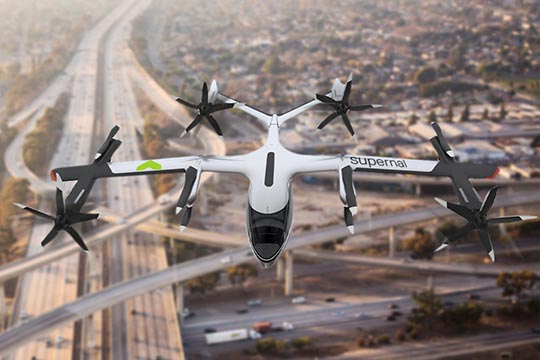
Advanced Air Mobility Takes Flight With New Partnership
The exploration of airborne transportation and advanced air mobility is the focus of a new partnership with an advanced air mobility company from Hyundai Motor Group. This new project will take a holistic look at advanced air mobility, concentrating on the feasibility, opportunities, and challenges of building electric vertical takeoff and landing stations—otherwise known as vertiports—for future autonomous air vehicles. NREL researchers are evaluating the potential locations, travel destinations, and energy demand that will shape the development of this innovative mobility network.
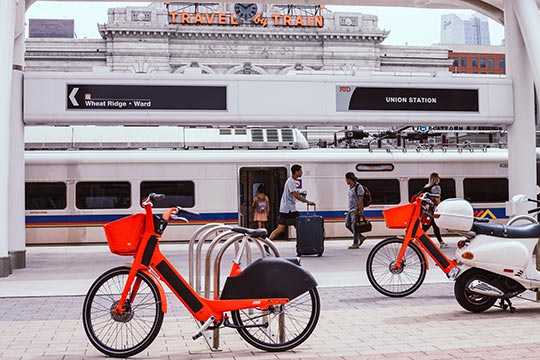
Analysis Reveals Energy Impacts of Shared Micromobility
Researchers used travel-demand data from the National Household Travel Survey to perform a comprehensive analysis on the potential energy impacts of shared micromobility options, including e-bikes, e-scooters, seated scooters, and bicycles. NREL's study estimates high adoption of shared micromobility can save as much as 2.3 billion gasoline-equivalent gallons per year nationwide. It is anticipated that city authorities and planning agencies can use these findings to support decision-making around this emerging mode.
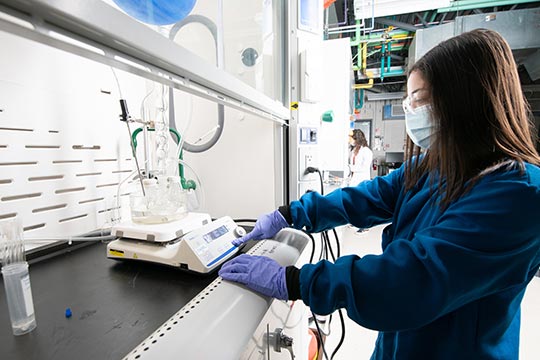
Plant-Based Epoxy Enables Recyclable Carbon Fiber, Improves Economics for Mass Market Electric Vehicles
Today's carbon fiber—at once strong and featherweight—is made by setting woven carbon filaments in glue-like epoxy, yielding a material that can boost car fuel efficiency by 35% but cannot be effectively recycled. That reality is changing quickly after NREL researchers showed how using plant-based epoxies and an anhydride hardener can make the material fully recyclable. Using a special catalyst, the NREL team was able to break down the resin at room temperature, allowing them to recover the carbon filaments while maintaining their quality and alignment.
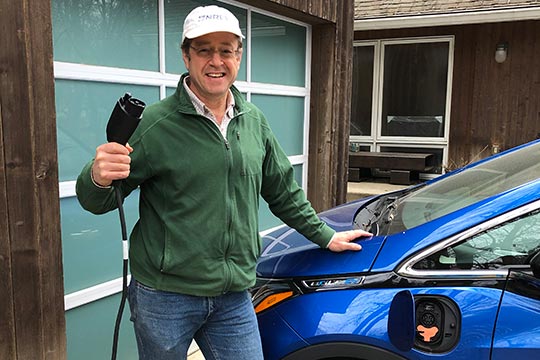
NREL's Ted Sears Supports White House Effort To Convert Federal Fleet to Electric Vehicles
NREL fuel and vehicle regulations expert Ted Sears is supporting White House efforts to convert the federal fleet to zero-emission vehicles. The appointment follows a January 2021 Biden administration executive order setting a goal of achieving 100% acquisition of zero-emission federal fleet vehicles. Alongside his deep technical knowledge in executing federal fleet policy, Sears has access to abundant mobility data and a deep bench of NREL researchers to inform his efforts.
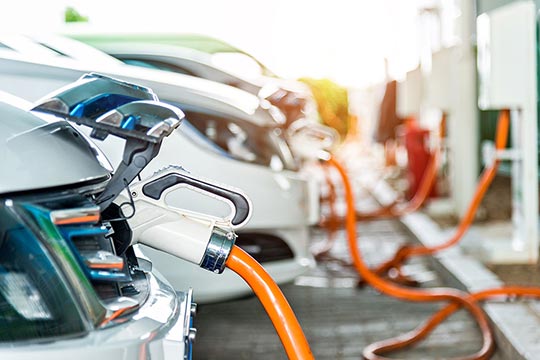
Aligning Utilities and Electric Vehicles, For the Greater Grid
Many studies have considered the benefits of electric vehicle (EV) managed charging or shifting charging to a time and place that supports the electric grid. A recent literature review from NREL compiles existing information on the overall potential value of EV managed charging to identify challenges and opportunities. This study found significant benefits to managed charging, such as decreased emissions and power system costs and increased reliability. However, researchers also emphasize that the potential value changes with power system characteristics and EV use.
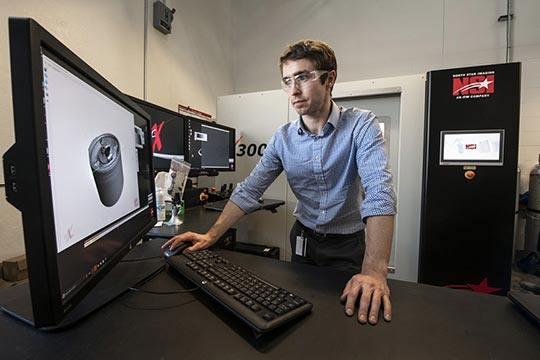
Building Better Batteries: Architecture for Energy Storage
One of the greatest challenges in lithium-ion (Li-ion) battery research is the microscopic scale of the work; small details often result in big impacts to battery performance. A recent breakthrough by NREL and the University of Ulm advances the way researchers measure and analyze battery materials by artificially generating a representative architecture of a Li-ion electrode particle with sub-particle grain detail. This first-of-its-kind artificial electrode will allow researchers to manipulate the model to evaluate opportunities for battery design improvements.
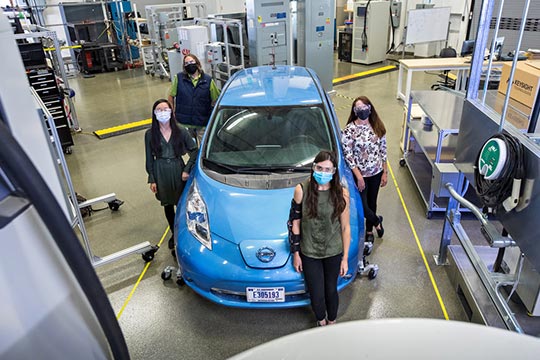
Electric Vehicle Charging at Retail Locations Offers Convenience, Building Integration Opportunities
Researchers are intensifying efforts to understand and mitigate the impacts of increased power demand from EVs on the electric grid by comparing load profiles from potential EV charging stations against those of big-box retail grocery stores. With EV charging power demands estimated to dwarf the already significant requirements of retail establishments, these load profiles can inform strategies for maximizing energy storage capacity with behind-the-meter storage solutions. NREL's new EVI-EDGES model (Electric Vehicle Infrastructure – Enabling Distributed Generation Energy Storage) allows building owners to identify optimal designs to manage the impact of EV charging with flexible energy loads.
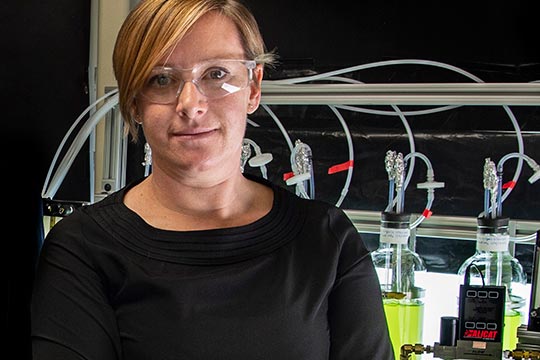
With NREL's Feedstock Research, Algae and Garbage Could Be Ingredients for Zero-Emissions Fuels of the Future
According to the U.S. Department of Energy Bioenergy Technologies Office's Billion-Ton Report, over 1 billion tons of biomass could be sustainably collected and processed into biofuels by 2030 in the United States. NREL is helping unlock the full potential of that feedstock supply after receiving over $2 million from the office. The funding will support research on growing photosynthetic algae and efficiently sorting municipal solid waste—important steps for making both feedstocks more economical ingredients for net-zero-emission biofuels.
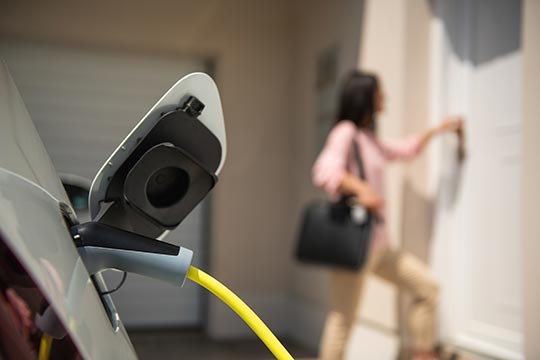
Study Supports Equitable Deployment of Electric Vehicle Charging Infrastructure
A nationwide study conducted by NREL researchers estimates that in a future all-EV scenario, at least one-quarter of the U.S. population will not have reliable access to home charging options in the long term, absent policy action and thoughtful community buildout. As more people buy EVs, researchers note that planners must consider developing residential charging infrastructure solutions for households that don't have consistent access to overnight home charging, especially for multifamily dwellings.

Podcast Brings Clean Transportation Conversations to Life
A new podcast produced by NREL and the Clean Cities Coalition Network presents a fresh way to highlight how we can bring more affordable, accessible, and sustainable transportation to the streets today and improve the mobility options of tomorrow. The On the Go podcast leverages Clean Cities' expertise in deployment of sustainable transportation technologies by providing an engaging, portable way for communities to get training and information on the latest research, trends, tools, and news about alternative fuels and advanced vehicle technologies.
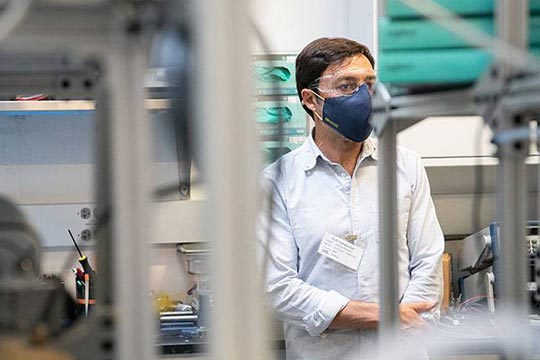
Electric Hydrogen Partnership Hopes To Repeat Success With Renewable Hydrogen Technology
NREL and clean hydrogen company Electric Hydrogen are working together to scale clean hydrogen and invent new opportunities for decarbonization. The collaboration will diagnose sources of degradation in commercial electrolysis cells and validate advanced designs that use higher stack currents. Electric Hydrogen is working on a high-performance product for water electrolysis that could scale up to commercial applications, and NREL's electrolyzer stack testing capabilities will allow it to characterize efficiency, durability, and performance across a range of operating conditions.
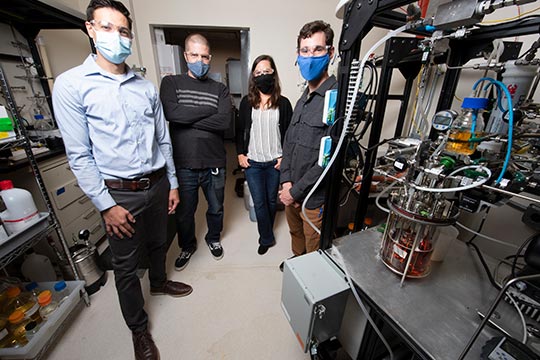
NREL Process for Renewable Butyric Acid Good for Environment, Cheaper Biofuels
A new process for making a promising precursor for diesel and jet fuel from lignocellulosic biomass results in a 50% reduction in greenhouse gas emissions compared to traditional biological production routes. NREL scientists developed the fully integrated process to produce biomass-derived butyric acid and for less expense than the selling price of the same material from petroleum. The scientists estimate their biomass-derived butyric acid can be sold at 55% of the current selling price of petroleum-derived butyric acid.
Get To Know Our Team: Matt Keyser
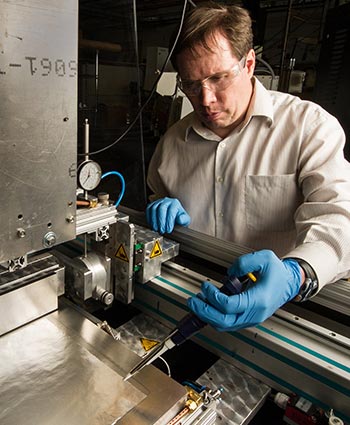
A conversation with NREL's Matt Keyser, manager of the electrochemical energy storage group
What is your primary research focus at NREL?
My primary research focus is electrochemical energy storage systems, essentially enabling new battery technologies for transportation applications. Today, Li-ion batteries are highly efficient and favored throughout the transportation industry, but that wasn't always the case. When I first started at NREL, my focus was on improving the efficiency of electrochemical energy storage systems by evaluating various battery chemistries and additives. Over the years, we have progressed through a number of lithium chemistries, from lithium-cobalt-oxide electrodes to more nickel-manganese-cobalt electrodes to lithium iron phosphate.
Currently, my research explores cutting-edge strategies to improve the efficacy, resiliency, and recyclability of batteries to meet mobility demand for cars, planes, drones, and other takeoff and landing vehicles. My team uses new strategies, such as machine learning, to understand degradation mechanisms and investigate new chemistries, including silicon and solid-state electrolytes, to reduce the dependence on critical materials while increasing safety.
In your field of research, what one mobility challenge do we need to prioritize in the next 5 years?
Our battery research must expand to include medium- and heavy-duty vehicles. Even as we explore other systems for these vehicles, such as hydrogen, batteries will provide the energy storage necessary to support responsive acceleration, optimize regenerative braking, and streamline the transition to these new technologies.
In addition, it is important that we continue to prioritize the recovery of materials that have earth abundancy issues by recycling Li-ion batteries. Currently, the critical material in high demand is cobalt. However, even as we transition to alternative materials such as nickel, it will be crucial to recover and recycle materials to support the Li-ion battery supply chain. Nickel is used for stainless steel, copper, and lithium throughout our economy and could become less available as electric cars increase in popularity. Our battery recycling research focuses on direct recycling to reuse a value-added product. For instance, we upcycle old/aged cathode materials for use in future batteries, but lithium battery designs are not monolithic, and a lot of work still needs to be done.
What sparked your interest in researching sustainable mobility?
I grew up in Colorado, and I've always been passionate about the environment. The mountains and wildlife have had a profound impact on my life. One of my core hobbies is scuba diving, and I've seen the negative impacts of climate change on the reefs. I worry about future generations because I want them to have access to the same experiences in nature. Working at NREL allows me to apply my skills to have a positive impact on sustainability and the environment so that other people can enjoy the same benefits in nature that I have.
Why does sustainable mobility matter?
The population of the world is increasing. Sustainable transportation is critical to meet the needs of a growing population. Beyond human mobility, transportation supports the global market and supply chain by distributing necessities, such as food, to people around the globe.
Must Reads
Solving Freeway Congestion Using Machine Learning
Freeway bottlenecks, such as at on-ramp merging areas, account for about 40% of recurring freeway congestion. Building more roads and adding more lanes won't solve the congestion problem, so dynamic traffic control measures like ramp meters and traffic signals offer better (and more cost-effective) alternatives. Read about how NREL researchers are leveraging deep reinforcement learning to solve highway on-ramp meter signal control in a recent IEEE Intelligent Transportation Systems conference paper.
On the Road to Extreme Fast Charging
The U.S. Department of Energy's aim of achieving 10-minute extreme fast charging is the latest target for lithium-ion EV batteries, propelling research to find suitable electrolyte candidates. Read the latest Energy Storage Materials article to learn how NREL, in partnership with Idaho and Argonne national laboratories, combined novel modeling and validation techniques to provide a comprehensive and holistic framework for selecting extreme fast charging electrolytes with desired performance characteristics.
Strategic Partnership Reveals Global Potential for American Ethanol
With millions of gasoline-powered vehicles on the road worldwide, all with varying technologies and emissions standards, how can we quickly accelerate their decarbonization today? Learn how NREL teamed up with the U.S. Grains Council to examine levels of ethanol blending in eight countries around the globe, highlighting the potential reach and impact of American ethanol exports.
HIVE: The Highly Integrated Vehicle Ecosystem Simulation Framework
As transportation systems evolve, the tools we use to understand these systems must also keep pace. With increases in vehicle electrification, automation, and ride-sharing, understanding how these trends interact and affect energy use, emissions, and other pieces of the mobility landscape becomes all the more urgent—and complex. Read more about HIVE, NREL's newest tool for modeling on-demand vehicle fleets, and how it's being leveraged to understand the transportation systems of tomorrow.
Did You Know?
Together, medium- and heavy-duty trucks account for 26% of national fuel use, despite making up just 4% of the total vehicle population. Greenhouse gas emissions from this segment continue to increase at a rate higher than any other transportation market in the United States. NREL's T3CO: Transportation Technology Total Cost of Ownership modeling framework is the first of its kind to enable levelized assessments of the full life cycle costs of advanced commercial vehicles—among the most critical metrics for mass adoption of electrified commercial vehicles.
In the News
More than 40% of Americans Live in Counties Hit by Climate Disasters in 2021
The Washington Post interviews Paty Romero-Lankao
To curb the increasing destruction of climate-related disasters, investment is needed
in both social infrastructure, such as access to health care, and action to improve
human connection, like concentrated outreach to marginalized groups and cultivating
stronger neighborhood networks.
On the Road Toward Renewable Energy, Japan Is Betting on Hydrogen
CBS News interviews Keith Wipke
Japan's commitment to hydrogen as a vehicle fuel could benefit it in the long run
as hydrogen plays a more important role in heavy-duty transportation, long-duration
energy storage, and decarbonization of off-road sectors.
CiviCO Honors 2021 Colorado Governor's Citizenship Medal Winners
Colorado governor recognizes NREL's Nick Muerdter
NREL software engineer Nick Muerdter received a 2021 Colorado Governor's Citizenship
Medal for his work developing the Vaccine Spotter website, which aggregated vaccine
appointment schedules into a search tool for people across the country to locate the
nearest available appointment.
Industry Sees State as Alluring Opportunity for Low-Carbon Hydrogen
Casper Star Tribune interviews Keith Wipke
Clean hydrogen is gaining momentum as a stable fuel source to power high-emitting
sectors and balance out the variability of other fuel types, and Wyoming could be
the industry hub.
EV Charging Shifts Gears From Range to Speed
Bloomberg cites NREL's EVSE Quarterly Trends Report
EV range is becoming less of a consideration than charging speed. NREL's latest electric
vehicle supply equipment report shows a surge in fast-charging stations from 2020
to 2021 to alleviate this concern.
Share

